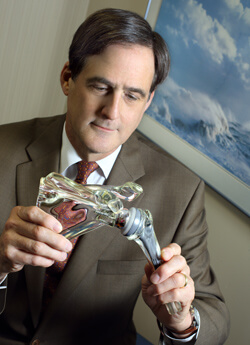
Johns Hopkins Orthopaedic Surgery
July 17, 2014
The reverse shoulder replacement prosthesis may address more conditions.

Unlike a traditional shoulder replacement, which mimics how the ball and socket are naturally situated in the shoulder, the rTSA installs the ball prosthesis on the socket side of the joint and the socket prosthesis on the ball side of the joint. Although rTSA is typically recommended for patients who have a damaged rotator cuff with arthritis, McFarland says the surgery can also help those who have rotator cuff damage—pseudoparalysis—but no arthritis. “The rTSA prosthesis allows them to regain all or some of their range of motion,” he says. “Some patients have really great results after the operation.”
The reverse replacement is also finding use in place of a hemiarthroplasty to restore the ball part of the joint. “The hemi surgery didn’t work very well over the years,” says McFarland, “but a reverse in the same population has been pretty successful in addressing pain from arthritis.”
Who is eligible for the rTSA procedure?
For patients with significant bone loss, McFarland can perform the rTSA without having to do a bone graft in the socket, as is required with a traditional replacement. This is a significant advantage because bone grafting around a regular replacement has high failure rates.
Other situations in which an rTSA can be used successfully are for failed standard shoulder replacements when the failure is due to rotator cuff tears, dislocation or instability of the replacement, or infection. The rTSA has been utilized successfully in patients with rheumatoid arthritis, psoriatic arthritis, shoulder dysplasia and after shoulder fractures.
In the past, the operation was recommended only for patients age 70 and older. McFarland’s experience, however, shows it can be successful in those under 70 as well. “We’ve found it beneficial for patients from their 60s all the way into their early 90s,” he says. “It has a lot of versatility, is good for a variety of conditions and is a great advancement in the field of shoulder surgery.”
To learn more, call 443-997-9330.

